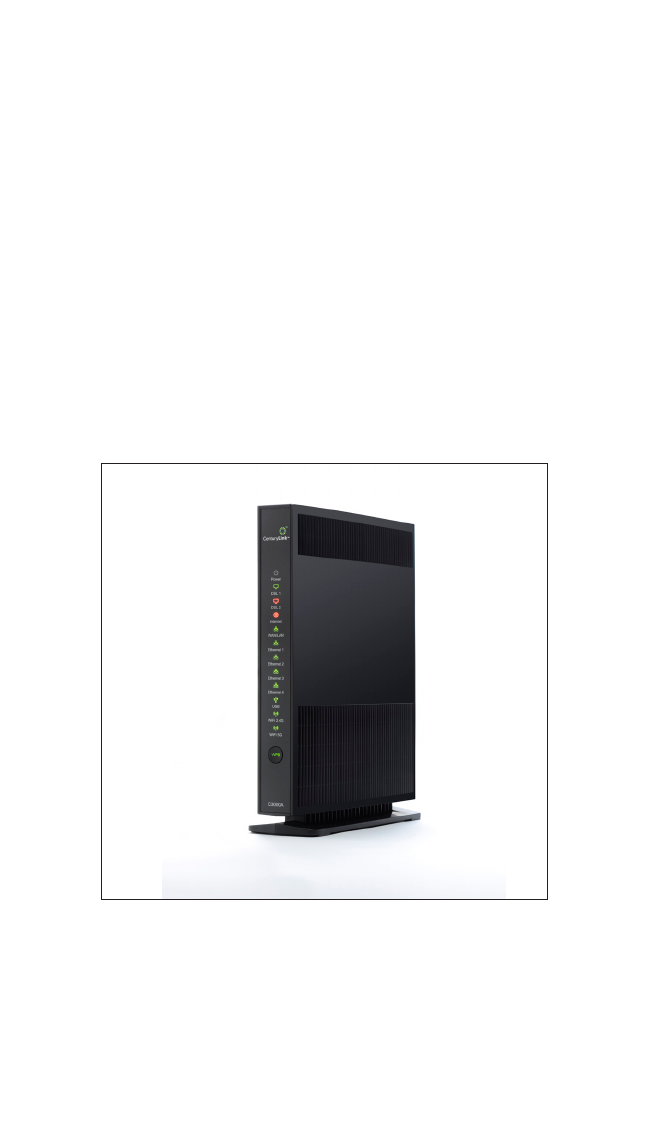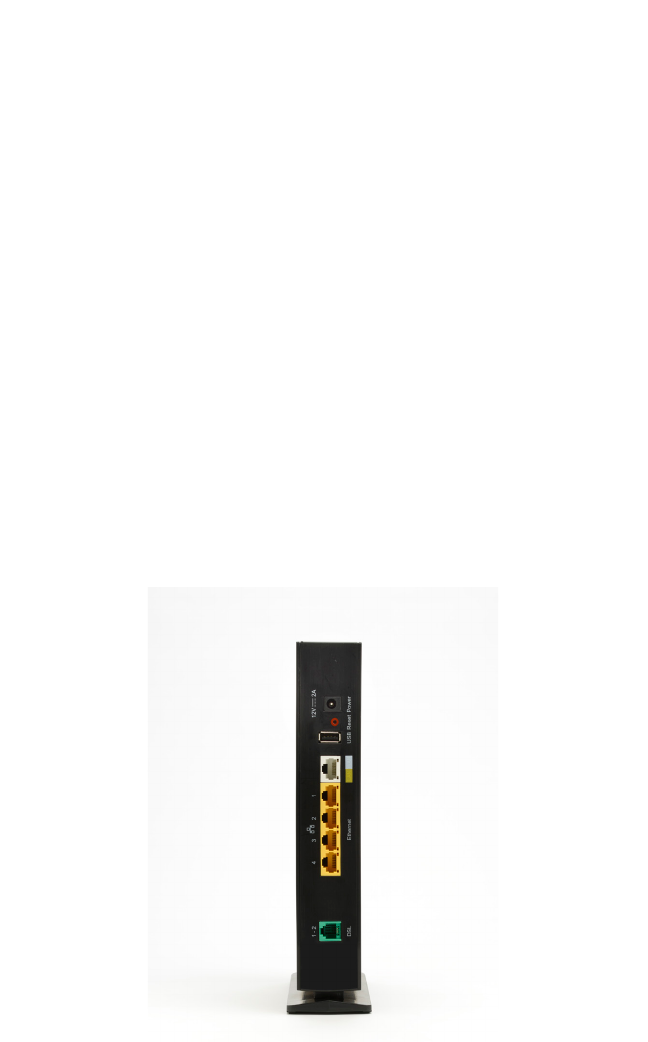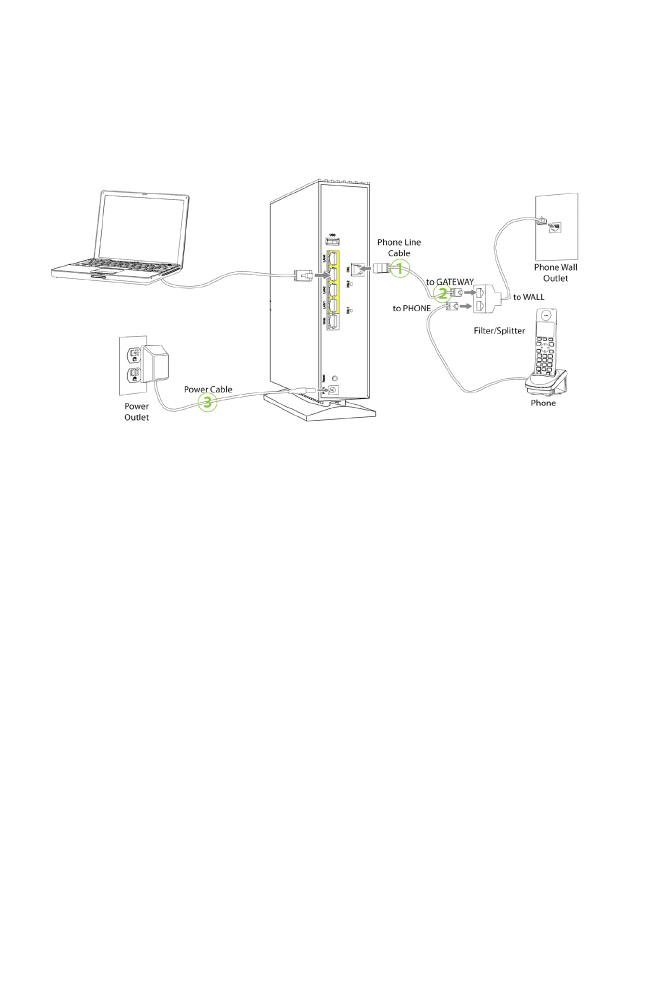Actiontec Electronics C3000A 802.11n and 802.11ac Wi-Fi Router User Manual
Actiontec Electronics Inc 802.11n and 802.11ac Wi-Fi Router Users Manual
Contents
- 1. Users Manual
- 2. Compliance Notice
- 3. User Manual
Users Manual

User Manual
802.11n and 802.11ac
Wi-Fi Router
Model # C3000A
0535-00xx-000

i
Table of Contents
1 Introduction 4
Package Contents 5
Minimum System Requirements 5
Features 5
Getting to Know the Router 6
Connecting the Router 9
2 Accessing the Home Screen 11
Accessing the Home Screen 11
Icon Bar 12
Connection Status 12
3 Checking the Router’s Status 13
Accessing the Status Screens 13
Connection Status 14
Line 1/Line 2 Status 14
WAN Ethernet 14
Routing Table 15
Firewall Status 15
NAT Table 15
Wireless Status 16
Advanced Wireless Status 16
Wireless Monitor 16
Modem Utilization 17
LAN Status 17
ARP Table 17
Network Devices 17
Interface Statistics 18
Multicast Statistics 18
System Log 18
4 Configuring Wireless Settings 19
Accessing Wireless Settings 19
i

ii
C3000A 802.11n and 802.11ac Wi-Fi Router
ii
Basic Settings 20
Advanced Settings 21
WPS 21
MAC Address Control 21
WDS 22
Band Steering 22
5 Configuring Firewall Settings 23
Accessing Firewall Settings 23
Firewall 24
IPv6 Firewall 24
Port Forwarding 24
Applications 25
DMZ Hosting 25
IPv6 DMZ Hosting 26
UPnP 26
5 Advanced Settings 27
Accessing the Advanced Setup Screens 27
Services Blocking 28
Website Blocking 28
Scheduling Access 28
Parental Controls 28
WAN IP Addressing 29
IPv6 WAN Settings 29
RFC1483 Transparent Bridge 30
IPv6 LAN Settings 30
DHCP Reservation 30
Dynamic DNS 30
DNS Host Mapping 31
IP QoS Upstream Settings 31
IP QoS Downstream Settings 31
IPv6 Q0S 32
Remote GUI 32
Remote Telnet 32
Dynamic Routing 32
Admin Password 33
Storage Device Info 33
Samba Configuration 33

iii
C3000A 802.11n and 802.11ac Wi-Fi Router
Reboot 34
Restore Defaults 34
Upgrade Firmware 34
Check for New Firmware Link 34
LAN IP Settings 35
Static IP LAN 35
Speed Test 35
Ping Test 35
Tcpdump Debug 36
Iperf Test 36
IPv6 Ping Test 36
Traceroute 36
IPv6 Traceroute 37
Time Zone 37
Language Settings 37
DNS Cache 37
IGMP Setting 38
Upgrade History 38
ALG 38
Tool Box 38
DLNA 39
xDSL Diagnostics 39
Print Server 39
A Specifications 40
General 40
Wireless Operating Range 41
LED Indicators 41
Power Adapter 41
Environmental 42
Notices 43
Warranty 43
Important Safety Instructions 43
FCC Class B Equipment 44
Important Note on Wi-Fi 45
Contact Info 46

4
Introduction
Congratulations for purchasing the C3000A 802.11n and 802.11ac Wi-Fi
Router. The Router is a single platform device that supports universal
WAN access, FTTN, FTTdp, FTTB, or FTTP. With support for advanced
802.11ac 4x4 WiFi, the Router enables blazing fast HD video
streaming, with multi-channel HD video throughput. The Router also offers
an unprecedented level of security, helping protect your network
resources. It has also been designed to deliver unparalleled WiFi
performance, using dual-band WiFi supporting speeds up to 2.3 Gbps.
1

5
C3000A 802.11n and 802.11ac Wi-Fi Router
Package Contents
• Black Power adapter
• Yellow cable (Ethernet, 6 ft.)
• White cable (Ethernet, 10 ft.)
• Green cable (RJ14, 12 ft.)
• Quick Start Guide
• Installation Guide
• Wall-mount template
• Vertical stand
Minimum System Requirements
• Active ADSL2+ service
• Computer with an 10 Mbps or 10/100/1000 Mbps Ethernet
connection
• Microsoft Windows 10, 8, 7; Mac OS OS X+
• TCP/IP network protocol installed on each computer
Features
• ADSL2+, VDSL2, and WAN Ethernet in a single CPE
• Dual Band WiFi delivering up to 2.3 Gbps with 802.11ac 4x4 5GHz
and 802.11n 3x3 2.4GHz
• Optimized for IPTV and Video over WiFi

6
Introduction
Getting to Know the Router
This section contains a quick description of the Router’s lights, ports, and
other features. The Router has several indicator lights (LEDs) and a button
on its front panel, and a series of ports and switches on its rear panel.
Front Panel
The front panel of the Router features 13 LEDs and a WPS (Wireless
Protected Setup) button.
Power
The Power LED illuminates green when the Router is properly connected
to a WAN Internet connection.
DSL 1/DSL2
The DSL LEDs illuminate green when the Router is properly connected
to a DSL Internet connection.
Internet
The Internet LED illuminates green when the Router is properly
connected to a WAN Internet connection.
Ethernet
The Ethernet LED illuminates green when the Router is properly
connected to a WAN Ethernet connection.
Ethernet 1/2/3/4
The Ethernet LEDs illuminate green when the Router is properly
connected to a LAN Ethernet connection.

7
C3000A 802.11n and 802.11ac Wi-Fi Router
USB
The USB LED illuminates green when the Router is properly
connected to a USB connection.
Wi-Fi 2.4G/5G
The Wi-Fi LEDs illuminate green when the Router’s wireless network is
operating and properly configured in each band.
WPS Button
The WPS button is used when connecting a wireless device to the
Router’s wireless network using WPS.
Rear Panel
The rear panel of the Router features 8 ports, and a Reset button.
Power Port
The Power port is used to connect the Power cord (Model No.
CDS024T-W120U by Adapter Tech) to the Router.
Reset Button
Depressing the Reset button for 10 seconds will restore the
Router’s factory default settings. The reset process will start after
releasing the button.
WARNING! Do not unplug the Power cord from the Router
during the reset process. Doing so may result in permanent
damage to the Router.

8
Introduction
WAN Ethernet Port
The WAN Ethernet port is used to connect the Router to a WAN
connection via an Ethernet cable.
LAN Ethernet Ports (4)
The LAN Ethernet ports are used to connect computers to the Router
via Ethernet cable. The Ethernet ports are 10/100/1000 Mbps auto-
sensing ports, and either a straight-through or crossover Ethernet cable
can be used when connecting to the ports.
USB Port
The USB port is used to connect the Router to a USB device.
DSL Port (Single & Bonded)
The DSL port is used to connect the Router to a DSL wall outlet via
DSL cable.

9
C3000A 802.11n and 802.11ac Wi-Fi Router
Connecting the Router
There are many variables involved when connecting the Router, depending
on the type of Internet service available. The figure below shows the
possible connections available for the Router.
Connecting a Computer to the Router
To connect a computer to the Router to access the Router’s graphical
user interface (GUI):
1. Get the Router and black Power cord from the box.
2. Plug the black Power cord in the black port on the back of the Router
and then into a power outlet.
3. Plug the yellow Ethernet cable from the box into one of the four yellow
Ethernet ports on the back of the Router.
4. Make sure the computer is powered on, then plug the other end of the
yellow Ethernet cable into an Ethernet port on the computer.

10
Introduction
5. Make sure that the LED on the LAN port into which the Ethernet cable
is plugged glows steadily green. This may take a few moments.
6. The computer should either be configured with a statically defined IP
address and DNS address, or instructed to automatically obtain an
IP address using the Network DHCP server. The Router is set up, by
default, with an active DHCP server, and it is recommended to leave
this setting as is.

11
Accessing the
Home Screen
This chapter gives a short overview of the Home screen of the Router’s
graphical user interface (GUI).
Accessing the Home Screen
To access the Home screen:
1. Open a Web browser on computer connected, via Ethernet cable, to
one of the Router’s LAN ports. In the Address text box, type:
http://192.168.0.1
then press Enter on the keyboard.
2. The Router’s Home screen appears.
The Router’s GUI is now accessible.
2

12
C3000A 802.11n and 802.11ac Wi-Fi Router
Icon Bar
At the top of the Home screen is the Icon Bar. Here, you can quickly
access the other four main sections of the Router’s GUI by clicking on the
appropriate icon: Status (see chapter 3 for more details); Wireless Setup
(see chapter 4 for more details); Firewall (see chapter 5 for more details);
Advanced Setup (see chapter 6 for more details). Clicking Home in any
other screen generates the Home screen.
Connection Status
The bottom of the Home screen consists of connection and device
information relating to the Router. There are no configurable options here.

13
Checking the
Router’s Status
This chapter explains the options available on the Status screens, which
display information about the Router’s network connections.
Accessing the Status Screens
To access the Router’s Status screens:
1. Open a Web browser. In the Address text box, type:
http://192.168.0.1
then press Enter on the keyboard.
2. The Router’s Main screen appears. Click the Status icon.
3. The Connection Status screen appears. “Connection Status” is under
the “Internet Service” group.
From here, all the Status screens can be accessed from the menu on the
left.
3

14
C3000A 802.11n and 802.11ac Wi-Fi Router
Connection Status
Clicking Connection Status from any Status screen generates the
Connection Status (see figure above). Information concerning devices
connected to the Router’s network, whether wired or wireless, is
displayed here, along with the connected device’s IP address, MAC
address, and (if applicable) IPv6 address.
Line 1/Line 2 Status
Click Line 1 Status from any Status screen to generate the Line 1 Status
screen. This screen displays the Router’s DSL connection parameters
for DSL Line 1 port. Clicking Line 2 Status genreates the Line 2 Status
screen, which displays the connection parameters for the Router’s DSL
Line 2 port.
WAN Ethernet
Click WAN Ethernet Status from any Status screen to generate the
WAN Ethernet Status screen. This screen displays the Router’s WAN
(wide area network) parameters.

15
Checking the Router’s Status
Routing Table
Click Routing Table from any Status screen to generate the Routing Table
screen. This screen displays the Router’s routes.
Firewall Status
Click Firewall Status from any Status screen to generate the Firewall
Status screen. This screen displays parameters concerning the Router’s
firewall.
NAT Table
Click NAT Table from any Status screen to generate the NAT Table screen.
This screen displays the Router’s WAN (wide area network) parameters.

16
C3000A 802.11n and 802.11ac Wi-Fi Router
Wireless Status
Click Wireless Status from any Status screen to generate the Wireless
Status screen. This screen displays the Router’s wireless network
parameters.
Advanced Wireless Status
Click Advanced Wireless from the bottom of the Wireless Status
screen to generate the Advanced Wireless Statistics screen. This screen
displays the Router’s additional wireless network parameters.
Wireless Monitor
Click Modemstatus Wireless Monitor from the bottom of the Wireless
Status screen to generate the Wireless Monitor screen. This screen
displays parameters for the clients connected to the Router’s wireless
network.

17
Checking the Router’s Status
Modem Utilization
Click Modem Utilization from any Status screen to generate the Modem
Utilization screen. This screen displays statistics related to the Router’s
modem operation.
LAN Status
Click LAN Status from any Status screen to generate the LAN Status
screen. This screen displays the Router’s LAN (local area network)
parameters.
ARP Table
Click ARP Table from any Status screen to generate the ARP Table
screen. This screen displays the Router’s ARP (address resolution
protocol) table.
Network Devices
Click Network Device Table (underneath System Monitor) from any
Status screen to generate the Network - Devices screen. This screen
allows the user to scan the Router’s networks for new devices at a select-
ed time interval.

18
C3000A 802.11n and 802.11ac Wi-Fi Router
Interface Statistics
Click Interface Statistics from any Status screen to generate the
Estimated Interface Statistics screen. This screen displays various
statistics and parameters relating to the Router’s connection interfaces.
Multicast Statistics
Click Multicast Statistics from any Status screen to generate the
Multicast Statistics screen. This screen displays the Router’s multicast
statistics.
System Log
Click System Log from any Status screen to generate the System Log
screen. This screen displays the Router’s system log, which keeps track of
all events that occur on the Router.

19
Configuring
Wireless Settings
This chapter explains the options provided in the Wireless Setup
section of the Router’s firmware, including basic and advanced settings,
and WPS.
Accessing Wireless Settings
To access the Wireless Settings screens:
1. Open a Web browser. In the Address text box, type:
http://192.168.0.1
then press Enter on the keyboard.
2. The Router’s main screen appears. Enter the user name and
password, then click Wireless Setup from the row of icons at the top
of the screen.
3. The Basic Settings screen appears, with a menu of other wireless
options listed on the left side of the screen.
4

20
C3000A 802.11n and 802.11ac Wi-Fi Router
Basic Settings
Click Basic Settings from any Wireless Settings screen to generate the
Basic Settings screen, as shown in the figure above. This screen displays
a series of settings relating to the basic functionality of the Router’s
wireless network, including SSID (network name), frequency, and security.
Changing the Wireless Network Name (SSID)
To change the name of the Router’s wireless network, enter the new name
in the SSID Name text box in the Basic Settings screen, then click Apply.
Changing the Wireless Key/Passphrase
To change the passphrase for the Router’s wireless SSID, at the Security
Key Type, Use Custom Key/Passphrase, enter the desired Wireless
Key/Passphrase in the text box, then click Apply.
Enabling SSID Guest Option
Enabling this option in the Basic Settings screen allows guest users to
access the Router’s wireless Internet connection, while preventing these
users from accessing other wireless devices, including network printers or
other unsecured network devices. To enable, click Enable button next to
SSID Guest, then click Apply.

21
Configuring Wireless Settings
Advanced Settings
Click Advanced Settings from any Wireless Settings screen to generate
the Advanced Settings screen. This screen displays a series of settings
relating to the advanced capabilities of the Router’s wireless network,
including compatibility mode, channel width, and WMM power save.
WPS (Wi-Fi Protected Setup)
Click WPS from any Wireless Settings screen to generate the WPS
(Wi-Fi Protected Setup) screen, which allows the user to configure WPS
by following the onscreen instructions.
MAC Address Control
Click MAC Address Control from any Wireless Settings screen to
generate the Wireless MAC Authentication screen, which allows the user
to configure allow or deny access to the Router’s wireless network using
the MAC address of the wireless device. (Note: this feature only works if
Band Steering is DISABLED.) Follow the onscreen instructions to
configure.

22
C3000A 802.11n and 802.11ac Wi-Fi Router
WDS
Click WDS from any Wireless Settings screen to generate the WDS
Wireless Distribution System screen, which allows the user to configure
the Router to allow wireless interconnection of access points via a
wireless connection. Follow the onscreen instructions to configure.
Band Steering
Click Band Steering from any Wireless Settings screen to generate the
Band Steering Configuration screen, which allows the user to configure
the Router to automatically connect 2.4GHz and 5GHz wireless devices
to the appropriate wireless network bandwidth. Also, this screen can be
used to assign a certain wireless network and/or bandwidth to a particular
wireless device. Follow the onscreen instructions to configure.

23
Configuring
Firewall Settings
This chapter explains the options provided in the Firewall section of the
Router’s firmware, including setting up port forwarding and static NAT.
Accessing Firewall Settings
To access the Firewall screens:
1. Open a Web browser. In the Address text box, type:
http://192.168.0.1
then press Enter on the keyboard.
The Router’s Home screen appears. Click the Firewall icon.
2. The Firewall screen appears, with a menu of other wireless options
listed on the left side of the screen.
5

24
C3000A 802.11n and 802.11ac Wi-Fi Router
Firewall
Click General from any Firewall Settings screen to display the Firewall
screen, as shown in the figure above. To configure basic settings of the
Router’s firewall, follow the onscreen instructions.
IPv6 Firewall
Click IPv6 Firewall from any Firewall Settings screen to generate the
IPv6 Firewall screen. To set up, follow the onscreen instructions.
Port Forwarding
Click Port Forwarding from any Firewall screen to generate the Port
Forwarding screen.
Activating port forwarding allows the network to be exposed to the
Internet in certain limited and controlled ways, enabling some applications
to work from the local network (game, voice, and chat applications, for
example), as well as allowing Internet access to servers in the local
network. This screen allows you to configure the port forwarding settings
of the Router. If changes are made in this screen, click Apply at the
bottom of the screen to save them.
Port forwarding settings should only be adjusted by experienced technical
users who are extremely familiar with networking concepts.

25
Configuring Firewall Settings
Applications
Click Applications from any Firewall screen to generate the Applications
screen. This screen allows the user to designate certain applications to be
forwarded, circumventing the usual firewall security settings. If changes
are made in this screen, click Apply at the bottom of the screen to save
them.
DMZ Hosting
Click DMZ Hosting from any Firewall screen to generate the DMZ
Hosting screen. The DMZ host feature allows one device on the network
to operate outside the firewall to use an Internet service that otherwise
would be blocked, or to expose a networked device to all services without
restriction or security. To activate, click in the Enable radio button, then
type the device’s IP address in the appropriate text boxes.
Caution! A DMZ host is not protected by the firewall and may
be vulnerable to attack. Designating a DMZ host may also put
other computers in the local network at risk. When designating
a DMZ host, consider the security implications and protect it
if necessary.

26
C3000A 802.11n and 802.11ac Wi-Fi Router
IPv6 DMZ Hosting
Click IPv6 DMZ Hosting from any Firewall screen to generate the IPv6
DMZ Hosting screen. The DMZ host feature allows one device on the
network to operate outside the firewall to use an Internet service that
otherwise would be blocked, or to expose a networked device to all
services without restriction or security. To activate, follow the onscreen
instructions.
Caution! A DMZ host is not protected by the firewall and may
be vulnerable to attack. Designating a DMZ host may also put
other computers in the local network at risk. When designating
a DMZ host, consider the security implications and protect it
if necessary.
UPnP
Click UPnP from any Firewall screen to generate the UPnP screen, which
activates UPnP (Universal Plug and Play). To activate, set the preferred UPnP
options, then click Apply.

27
Advanced
Setup
This chapter explains the options available with the Advanced Setup
screens, which configure some of the more complex settings on the
Router.
Accessing the Advanced Setup Screens
To access the Router’s Advanced Setup screens:
1. Open a Web browser. In the Address text box, type:
http://192.168.0.1
then press Enter on the keyboard.
2. The Router’s Main screen appears. Click the Advanced Setup icon.
3. A WARNING screen appears. Technicians can click PROCEED to
configure the Advanced Settings of the Router.
4. The Services Blocking screen appears.
From here, all the Advanced Setup screens can be accessed from the
menu on the left.
6

28
C3000A 802.11n and 802.11ac Wi-Fi Router
Services Blocking
Click Services Blocking from any Advanced Setup screen to generate
the Services Blocking screen (see the figure, above). This feature allows
the user to block certain services from accessing the Router’s network(s).
Follow the onscreen instructions to configure.
Website Blocking
Click Website Blocking from any Advanced Setup screen to generate
the Website Blocking screen. This feature allows the user to block certain
websites from accessing the Router’s network(s). Follow the onscreen
instructions to configure.
Scheduling Access
Click Scheduling Access from any Advanced Setup screen to generate
the Scheduling Access screen. This feature allows the user to schedule
access to the Router’s network(s) for certain devices. Follow the onscreen
instructions to configure.
Parental Controls
Click Parental Controls from any Advanced Setup screen to generate
the Parental Controls Configuration screen. This feature allows the user
to allow or prevent access to certain websites for devices on the Router’s
network. Follow the onscreen instructions to configure.

29
Advanced Settings
WAN IP Addressing
Click WAN IP Addressing from any Advanced Setup screen to generate
the WAN IP Address screen. This feature allows the user to set the
protocol used by the ISP for Internet access. Follow the onscreen
instructions to configure.
IPv6 WAN Settings
Click IPv6 WAN Settings from any Advanced Setup screen to generate
the IPv6 WAN Settings screen. This feature allows the user to set the IPv6
protocol used by the ISP for Internet access. Follow the onscreen
instructions to configure.
WARNING: This setting should be configured by
experienced network technicians only, since any changes
could affect the Router’s IPv6 service.

30
C3000A 802.11n and 802.11ac Wi-Fi Router
How to Set the T3200 to RFC1483 Transparent Bridge
From the WAN IP Address screen, select RFC 1483 Transparent
Bridging and click Apply. The Router will allow the WAN IP address to
pass-through to the device connected to LAN Port 1 Only.
IPv6 LAN Settings
Click IPv6 LAN Settings from any Advanced Setup screen to generate
the IPv6 LAN Settings screen. This feature allows the user to set the IPv6
LAN IP settings on the Router. Follow the onscreen instructions to
configure.
DHCP Reservation
Click DHCP Reservation from any Advanced Setup screen to
generate the DHCP Reservation screen. This feature allows the user to
lease a permanent DHCP-allocated address to a client on the Router’s
network. Follow the onscreen instructions to configure.
Dynamic DNS
Click Dynamic DNS from any Advanced Setup screen to generate the
Dynamic DNS screen. This feature allows the user to associate the WAN
IP address of the Router with a host name. Follow the onscreen
instructions to configure.

31
Advanced Settings
DNS Host Mapping
Click DNS Host Mapping from any Advanced Setup screen to generate
the DNS Host Mapping screen. This feature allows the user to create a
static host name for a specified IP address. Follow the onscreen
instructions to configure.
IP QoS Upstream Settings
Log in as root to generate the IP QoS Upstream Settings screen. This
feature allows the user to prioritize certain types of upstream data traffic
over standard upstream data traffic. Follow the onscreen instructions to
configure.
IP QoS Downstream Settings
Log in as root to generate the IP QoS Downstream Settings screen. This
feature allows the user to prioritize certain types of downstream data traffic
over standard downstream data traffic. Follow the onscreen instructions to
configure.

32
C3000A 802.11n and 802.11ac Wi-Fi Router
IPv6 QoS
Log in as root to generate the IPv6 QoS Settings screen. This feature
allows the user to prioritize certain types of IPv6 data traffic over standard
IPv6 data traffic. Follow the onscreen instructions to configure.
Remote GUI
Log in as root to generate the Remote GUI screen. This feature allows
the user to access the Router’s graphical user interface from a remote
location. Follow the onscreen instructions to configure.
Remote Telnet
Log in as root to generate the Remote Telnet screen. This feature allows the
user to access the Router from a remote location via telnet. Follow the
onscreen instructions to configure.
Dynamic Routing
Click Dynamic Routing from any Advanced Setup screen to generate
the Dynamic Routing (RIP) screen. This feature allows the user to set up
the Router on the network behind a modem using dynamic routing. Follow
the onscreen instructions to configure.

33
Advanced Settings
Admin Password
Click Admin Password from any Advanced Setup screen to generate
the Admin Password screen. This feature allows the user to change the
password for accessing the Router’s graphical user interface. Follow the
onscreen instructions to configure.
Storage Device Info
Click Storage Device Info from any Advanced Setup screen to generate
the Storage Service screen. This feature allows storage devices connected
to the Router to be easily accessed. Any storage devices connected to the
Router will be listed in the table at the bottom of the screen.
Samba Configuration
Click Samba Configuration from any Advanced Setup screen to gener-
ate the Samba Configuration screen. This feature allows the user to set up
a Samba environment. Follow the onscreen instructions to configure.

34
C3000A 802.11n and 802.11ac Wi-Fi Router
Reboot
Click Reboot from any Advanced Setup screen to generate the Reboot
screen. Reboot the Router by clicking Reboot.
Restore Defaults
Click Restore Defaults from any Advanced Setup screen to generate the
Restore Defaults screen. To restore certain settings on the Router, click
the appropriate Restore button.
Upgrade Firmware
Click Upgrade Firmware from any Advanced Setup screen to generate
the Upgrade Firmware screen. To upgrade the Router’s firmware, follow
the onscreen instructions.
Check for New Firmware Link
Click Check for new firmware link from any Advanced Setup screen
to generate the Upgrade firmware from Internet screen. To upgrade the
Router’s firmware from the Internet automatically, click Upgrade.

35
Advanced Settings
LAN IP Settings
Click LAN IP Settings from any Advanced Setup screen to generate the
LAN IP and DHCP Settings screen. This feature allows the user to set LAN
IP and DHCP server settings on the Router. Follow the onscreen
instructions to configure.
How to Manually Set the T3200 for Static IP
From the WAN IP Address screen, select RFC 1483 via Static IP. Enter
the IP address to be assigned to the Router, the subnet mask and the IP
Address of the Default Router. Click Apply.
Speed Test
Click Speed Test from any Advanced Setup screen to generate the
Speed Test screen. This screen allows the user to perform a speed test on
the Router’s Internet (or WAN) connection. Enter the URL for a server at a
speed test site, then click Test.
Ping Test
Click Ping Test from any Advanced Setup screen to generate the Ping
Test screen. To perform a ping test on the Router, follow the onscreen
instructions.

36
C3000A 802.11n and 802.11ac Wi-Fi Router
Tcpdump Debug
Click Tcpdump Debug from any Advanced Setup screen to generate the
Tcpdump Debug screen. This screen allows the user to copy the packet
capture file to a USB flash drive connected to the Router, along with the
CFE and wireless configuration files, for debugging purposes. Follow the
onscreen instructions to complete.
Iperf Test
Click Iperf Test from any Advanced Setup screen to generate the Iperf
Test screen. To perform an iperf test on the Router, follow the onscreen
instructions.
IPv6 Ping Test
Click IPv6 Ping Test from any Advanced Setup screen to generate the
IPv6 PingTest screen. To perform an IPv6 ping test on the Router, follow
the onscreen instructions.
Traceroute
Click Traceroute from any Advanced Setup screen to generate the
Traceroute screen. To perform an route trace on the Router, follow the
onscreen instructions.

37
Advanced Settings
IPv6 Traceroute
Click IPv6 Traceroute from any Advanced Setup screen to generate the
IPv6 Traceroute screen. To perform an IPv6 route trace on the Router,
follow the onscreen instructions.
Time Zone
Click Time Zone from any Advanced Setup screen to generate the Time
Zone screen. Use this screen to set the time zone on the Router.
Language Settings
Click Language Settings from any Advanced Setup screen to generate
the Language Settings screen. Use this screen to set the language on the
Router’s graphical user interface.
DNS Cache
Click DNS Cache from any Advanced Setup screen to generate the DNS
Cache screen. Use this screen to set up a DNS cache on the Router.

38
C3000A 802.11n and 802.11ac Wi-Fi Router
IGMP Setting
Click IGMP Setting from any Advanced Setup screen to generate the
IGMP Configuration screen. Use this screen to set up IGMP processes on
the Router.
Upgrade History
Click Upgrade History from any Advanced Setup screen to generate the
Upgrade History screen. This screen displays a list of firmware upgrades
applied to the Router.
ALG
Click ALG from any Advanced Setup screen to generate the Firewall -
ALG / Pass-Through screen. This screen allows the user to configure ALG
settings on the Router.
Tool Box
Click Tool Box from any Advanced Setup screen to generate the Tool Box
screen. This screen allows the user to configure traffic and port mirroring
on the Router.

39
Advanced Settings
DLNA
Click DLNA from any Advanced Setup screen to generate the DLNA
screen. This screen allows the user to configure DLNA settings on the
Router.
xDSL Diagnostics
Click xDSL Diagnostics from any Advanced Setup screen to generate
the xDSL Diagnostics screen. This screen allows the user to select a type
of diagnostics on the Router.
Print Server
Click Print Server from any Advanced Setup screen to generate the Print
Server screen. This screen allows the user to select and configure a print
server for the Router’s network.

40
Specifications
General
Model Number(s)
C3000A 802.11n and 802.11ac Wi-Fi Router
Standards
IEEE 802.3 (10BaseT)
IEEE 802.3u (100BaseTX)
IEEE 802.11 b, g, n, ac (Wireless)
G.dmt
G.lite
t1.413
RFC 1483, 2364, 2516
Protocol
LAN - CSMA/CD
WAN - PPP, DHCP, Static IP
WAN
VDSL2 interface
LAN
10/100/1000 RJ-45 switched ports
Speed
LAN Ethernet: 10/100/1000 Mbps auto-sensing
Wireless: 802.11a, b, g, n, ac; 900 Mbps optimal (see Wireless
Operating Range for details)
A

41
C3000A 802.11n and 802.11ac Wi-Fi Router
Cabling Type
Ethernet 10BaseT: UTP/STP Category 3 or 5
Ethernet100BaseTX: UTP/STP Category 5
Wireless Operating Range
Indoors
Up to 91M (300 ft.) @ 300 Mbps
Outdoors
Up to 457M (1500 ft.) @ 300 Mbps
Topology
Star (Ethernet)
LED Indicators
Power, DSL 1, DSL 2, Internet, Ethernet, Ethernet 1, Ethernet 2, Ethernet 3,
Ethernet 4, USB, WiFi 2.4G, WiFi 5G, and WPS Push Button
Power Adapter
Model No.: CDS024T-W120U
Input: 120 VAC, 50/60Hz, 0.58A
Output: 12.0V === 2.0A
Manufacturer: Adapter Tech

42
Specifications
Environmental
Power
External, 12V DC, 2A
Certifications
FCC Part 15 Class B, Class C and E, FCC Part 68, UL
Operating Temperature
0º C to 45º C (32ºF to 113ºF)
Storage Temperature
-20ºC to 70ºC (-4ºF to 158ºF)
Operating Humidity
10% to 85% non-condensing
Storage Humidity
5% to 90% non-condensing

43
Notices
Warranty
This product has a one-year Limited Hardware Warranty and 90-day free
software updates from date of purchase.
Local Law
This Limited Warranty Statement gives the customer specific legal rights.
The customer may also have other rights, which vary from state to state in
the United States, and from country to country elsewhere in the world.
To the extent that this Limited Warranty Statement is inconsistent with
local law, this Statement shall be deemed modified to be consistent with
such local law. Under such local law, certain disclaimers and limitations of
this Warranty Statement may not apply to the customer.
Go to http://www.actiontec.com/products/warranty.php for more infor-
mation.
Important Safety Instructions
Basic safety precautions should always be followed to reduce the risk of
fire, electrical shock, and personal injury, including the following:
• Do not use this product near water – for example, near a bathtub,
kitchen sink, laundry tub, or swimming pool, or in a wet basement;
only clean with dry cloth.
• Do not block any ventilation openings. Install in accordance with
the manufacturer’s instructions. Do not install near any heat sources
such as radiators, heat registers, stoves, or other apparatus includ-
ing amplifiers that produce heat.
• Do not use the telephone to report a gas leak in the vicinity of the
leak.
• Use only the power cord indicated in this manual.

C3000A Wi-Fi Router
44
Coaxial Cable
If applicable, the coaxial cable screen shield needs to be connected to the
Earth at the building entrance per ANSI/NFPA 70, the National Electrical
Code (NEC), in particular Section 820.93, “Grounding of Outer Conductive
Shield of a Coaxial Cable,” or in accordance with local regulation.
FCC Class B Equipment
This equipment has been tested and found to comply with the limits for a
Class B digital device, pursuant to Part 15 of the FCC Rules. These limits
are designed to provide reasonable protection against harmful interference
in a residential installation. This equipment generates, uses and can radi-
ate radio frequency energy and, if not installed and used in accordance
with the instructions, may cause harmful interference to radio communica-
tions. However, there is no guarantee that interference will not occur in a
particular installation. If this equipment does cause harmful interference
to radio or television reception, which can be determined by turning the
equipment off and on, the user is encouraged to try and correct the inter-
ference by implementing one or more of the following measures:
• Reorient or relocate the device;
• Increase the separation between the equipment and receiver;
• Consult the dealer or an experienced radio or television technician
for help.
Modifications
The FCC requires the user to be notified that any changes or modifica-
tions made to this device that are not expressly approved by Actiontec
Electronics, Inc, may void the user’s authority to operate the equipment.

45
C3000A Wi-Fi Router
Declaration of Conformity for Products Marked With the FCC Logo
This device complies with part 15 of the FCC. Operation is subject to the
following two conditions:
1. This device may not cause harmful interference;
2. This device must accept any interference received, including interfer-
ence that may cause undesired operation of the device.
Important Note on Wi-Fi
If applicable, this equipment complies with FCC radiation exposure limits
set forth for an uncontrolled environment.
The radio has been found to be compliant to the requirements set forth in
CFR 47 Sections 2.1091, 15.247 (b) (4),15.407 addressing RF Exposure
from radio frequency devices as defined in Evaluating Compliance with
FCC Guidelines for Human Exposure to Radio Frequency Electromagnetic
Fields. The equipment should be installed more than 30 cm (~12 in.) from
your body or nearby persons.
For product available in the USA market, only channel 1~11 can be oper-
ated. Selection of other channels is not possible.
The device could automatically discontinue transmission in case of
absence of information to transmit, or operational failure. Note that this is
not intended to prohibit transmission of control or signaling information or
the use of repetitive codes where required by the technology.
The device for the band 5150-5250 MHz is only for indoor usage to
reduce potential for harmful interference to co-channel mobile satellite sys-
tems.
The maximum antenna gain permitted for devices in the band 5725-5825
MHz shall comp with the e.i.r.p. limits specified for point-to-point and non
point-to-point operation as appropriate.
The transmitter must not be co-located or operating in conjunction with
any other antenna or transmitter.

46
Notices
Contact Info
For questions regarding your product or the FCC declaration, contact:
Actiontec Electronics, Inc
3301 Olcott Street, Santa Clara, CA 95054, United States
Tel: (408) 752-7700
Fax: (408) 541-9003

C3000A Wi-Fi Router
FCC Part 68 User Manual Information
This equipment complies with Part 68 of the FCC rules. Located on the equip-
ment is a label that contains, among other information, the ACTA registration
number and ringer equivalence number (REN.) If requested, this information must
be provided to the telephone company.
The REN is used to determine the quantity of devices which may be connected to
the telephone line. Excessive REN’s on the telephone line may result in the devices
not ringing in response to an incoming call. In most, but not all areas, the sum of
the REN’s should not exceed five (5.0). To be certain of the number of devices that
may be connected to the line, as determined by the total REN’s contact the tele-
phone company to determine the maximum REN for the calling area.
This equipment cannot be used on the telephone company-provided coin service.
Connection to Party Line Service is subject to State Tariffs.
If this equipment causes harm to the telephone network, the telephone com-
pany will notify you in advance that temporary discontinuance of service may be
required. If advance notice isn’t practical, the telephone company will notify the
customer as soon as possible. Also, you will be advised of your right the file a
complaint with the FCC if you believe it is necessary.
The telephone company may make changes in its facilities, equipment, operations,
or procedures that could affect the operation of the equipment. If this happens, the
telephone company will provide advance notice in order for you to make the nec-
essary modifications in order to maintain uninterrupted service.
If trouble is experienced with this equipment, please contact:
Company Name:
Address:
TEL:
FAX:
Actiontec Electronics, Inc.
3301 Olcott St., Santa Clara, CA 95054
(408) 752-7700
(408) 541-9003
If the trouble is causing harm to the telephone network, the telephone company
may request you to remove the equipment from the network until the problem is
resolved.
This equipment uses the following USOC jacks: RJ14
It is recommended that the customer install an AC surge arrester in the AC outlet
to which this device is connected. This is to avoid damaging the equipment caused
by local lightening strikes and other electrical surges.